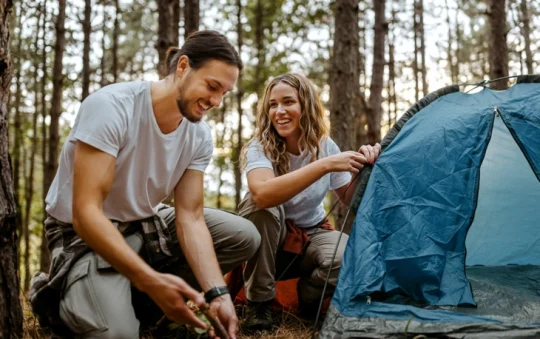Setting out on the journey of backpacking immerses individuals in the immense marvels of the natural world. Beyond the breathtaking vistas and meandering trails lies a crucial array of skills indispensable for any backpacker.
This manual delves into the fundamental rudiments that lay the groundwork for successful backpacking ventures. These abilities function as the guiding star, navigating adventurers through unfamiliar terrain, the haven providing refuge from the elements, and the nourishment sustaining their odyssey. Whether you’re an experienced hiker or a novice to the paths, mastering these skills is essential for safety and enhancing outdoor excursions.
Throughout this expedition, we’ll delve into essential navigation methods, explore the craftsmanship of erecting shelters and campsites, unveil tactics for managing sustenance and hydration, and prioritize safety and readiness for emergencies. Embracing these central tenets will equip you to embark on backpacking escapades confidently, fostering a deeper bond with the wilderness with every stride.
Join us on this journey as we uncover the essentials of backpacking and unlock the marvels of the great outdoors.
Navigation Skills
Mastering navigation techniques serves as the cornerstone of prosperous backpacking journeys, empowering you to confidently traverse varied landscapes and reach your intended destinations. Whether you’re navigating remote trails or venturing into uncharted wilderness, honing these skills is crucial for ensuring safety and tranquility.
Reading Maps:
Acquiring the ability to decipher topographic maps is a fundamental skill for all backpackers. These maps offer vital insights into the terrain, detailing elevation shifts, water sources, and notable landmarks. Grasping contour lines, symbols, and scale aids in accurately gauging distances and strategizing your path effectively.
Utilizing Compass:
Despite the popularity of GPS technology, a reliable compass remains indispensable for wilderness navigation, especially in regions with limited satellite connectivity. Familiarize yourself with basic compass navigation techniques, such as determining bearings, aligning the map, and employing the compass in conjunction with map features.
GPS Guidance:
GPS devices provide invaluable support in navigating challenging landscapes. Familiarize yourself with your GPS device’s functionalities, including setting waypoints, tracing routes, and utilizing breadcrumb trails for retracing steps. Nevertheless, always carry a paper map and compass as backups in case of device malfunction or battery depletion.
Orientation:
Prior to embarking on a hike, take the time to acquaint yourself with the surroundings. Identify prominent landmarks, discern the orientation of key features like rivers or mountain ranges, and mentally plot the area. Stay attentive to trail markers, intersections, and natural indicators to remain on course during your hike.
Preparation:
Thorough pre-trip preparation is essential for a rewarding backpacking excursion. Conduct extensive research on your intended route, considering trail conditions, potential risks, and available water sources. Develop alternative and contingency plans, and always communicate your itinerary to someone before embarking on your journey.
By refining your navigation prowess and regularly honing these skills, you’ll cultivate the confidence to explore new trails and wilderness expanses safely. Remember, navigation isn’t merely about finding your way—it’s also about relishing the journey and fully immersing yourself in the splendor of nature.
Setting Up Shelter and Campsites for Backpacking
Selecting an appropriate campsite and establishing shelter are crucial competencies for backpackers. A thoughtfully chosen campsite not only offers comfort and protection from the elements but also reduces environmental impact. Below are key factors to consider for shelter and campsite setup:
Choosing a Campsite:
Opt for a level, well-drained area, steering clear of potential hazards like fallen trees or rugged terrain. Take into account the proximity to water sources, prevailing winds, and sun exposure. Adhere to Leave No Trace principles by utilizing existing campsites whenever feasible to minimize environmental disturbance.
Varieties of Shelters:
Backpackers have a range of options including tents, hammocks, tarps, or bivy sacks. Each has its own advantages and drawbacks based on factors like weight, weather conditions, and personal preference. Practice setting up your chosen shelter in advance to streamline the process in the field.
Setting Up Your Shelter:
Ensure proper assembly to guarantee comfort and protection. Adhere to manufacturer guidelines for tents, ensuring they are securely pitched and anchored. When using hammocks or tarps, consider aspects such as angle and tree spacing for stability.
Organizing the Campsite:
Enhance efficiency and reduce impact by maintaining an organized campsite. Allocate specific areas for cooking, dining, sleeping, and storing gear. Safeguard food in bear-resistant containers to prevent wildlife encounters and ensure all waste is packed out.
Leave No Trace Principles:
Uphold Leave No Trace principles to safeguard wilderness areas. Dispose of waste responsibly, minimize the impact of campfires, and show respect for wildlife. Leave the campsite in better condition than you found it, allowing others to enjoy the pristine environment.
Mastering the setup of shelter and campsite guarantees a secure and enjoyable experience during backpacking excursions. Prioritize environmental stewardship to conserve wilderness areas for future generations to cherish.
Food and Water Management

Effective management of food and water is indispensable for sustaining energy, hydration, and overall health during backpacking expeditions. Understanding how to procure, treat, and conserve these vital resources ensures a secure and pleasant outdoor journey. Here are some fundamental principles for managing food and water:
Maintaining Hydration:
Maintaining adequate hydration is paramount for backpackers, particularly in hot and arid conditions. Carry a sufficient supply of water or identify dependable water sources along your route. Strategize your water intake to stay hydrated throughout the day, taking into account variables such as activity level, temperature, and humidity.
Water Purification:
Treating all water from natural sources is essential to prevent waterborne illnesses. Portable filtration systems, chemical tablets, or UV light devices effectively purify water in wilderness settings. Adhere to manufacturer guidelines for safe water purification.
Meal Preparation:
Meticulously plan your meals to ensure adequate nutrition and sustenance for your backpacking excursions. Opt for lightweight, non-perishable foods rich in calories and nutrients, such as dehydrated meals, nuts, dried fruits, and energy bars. Consider factors like weight, volume, and preparation time when selecting food for your trip.
Secure Food Storage:
Properly securing food is crucial to deter wildlife encounters and reduce environmental impact. Utilize bear-resistant containers or securely hang food and scented items, especially in areas frequented by bears. Keep food and waste away from your camping area to discourage wildlife and prevent potential conflicts.
Waste Disposal:
Adhere to Leave No Trace principles by minimizing food waste and disposing of scraps and packaging responsibly. Pack out all garbage, including wrappers and peels, to leave your campsite pristine. Avoid burying or burning food waste to prevent attracting wildlife and disrupting natural ecosystems.
By emphasizing efficient food and water management, you’ll maintain the essential energy and hydration levels required for safe and sustainable backpacking experiences. Plan ahead, stay hydrated, and minimize your environmental footprint to fully enjoy memorable outdoor adventures.
Safety and Emergency Preparedness
Prioritizing safety and readiness for emergencies is paramount for all backpackers, equipping them to effectively manage potential hazards and unexpected situations in the wilderness. By acquiring essential knowledge, honing skills, including basic skills, and assembling appropriate gear, you can mitigate risks and embark on outdoor adventures with confidence. Here are some key principles for safety and emergency preparedness:
First Aid Supplies:
Always carry a comprehensive first aid kit stocked with supplies to address common injuries and medical emergencies encountered while backpacking. Essentials like bandages, adhesive tape, antiseptic wipes, pain relievers, and treatments for blisters are indispensable for managing minor health concerns.
Emergency Shelter:
Include a lightweight emergency shelter, such as a space blanket, bivy sack, or compact tent, in your equipment to provide refuge from inclement weather or unforeseen overnight stays outdoors. Consider factors like durability, weather resistance, and ease of setup when selecting an emergency shelter.
Communication Equipment:
Bring along communication devices such as a cell phone, satellite phone, two-way radio, or personal locator beacon (PLB) to summon assistance in emergencies. Ensure these devices are fully charged and have reliable signal coverage for your hiking region.
Navigational Aids:
Carry dependable navigation tools like a map, compass, or GPS device to facilitate navigation through unfamiliar terrain. Familiarize yourself with basic navigation techniques such as map interpretation, compass navigation, and GPS usage to confidently navigate diverse landscapes.
Emergency Protocol:
Develop an emergency protocol outlining procedures to follow in various emergency scenarios such as injuries, becoming disoriented, or encountering severe weather. Share your itinerary and emergency protocol with a trusted individual before your journey, and establish a schedule for regular check-ins.
Weather Monitoring:
Stay informed about weather conditions in your hiking locale and be prepared to adapt your plans based on evolving weather forecasts. Monitor weather updates before and during your excursion, and be prepared to seek shelter or modify your route to avoid hazardous conditions.
Leave No Trace Ethos:
Adhere to Leave No Trace principles to minimize your ecological footprint and conserve natural areas for future generations. Keep your campsite tidy, carry out all waste and refuse, and refrain from disturbing wildlife or sensitive ecosystems.
Stay informed, be prepared, and take proactive measures to ensure a safe and enjoyable outdoor adventure.
In Conclusion
Mastering fundamental skills is essential for safe and enjoyable backpacking escapades amidst the breathtaking beauty of nature.
Proficiency in navigation is crucial for confidently traversing varied landscapes and reaching destinations smoothly. Setting up shelters and campsites efficiently ensures comfort and protection from the elements, while effectively managing food and water resources sustains energy levels throughout the journey. Prioritizing safety and readiness equips individuals to adeptly tackle unforeseen challenges.
Adhering to Leave No Trace principles remains paramount, minimizing ecological impact by meticulously removing waste and leaving campsites pristine. Embrace each adventure with inquisitiveness, modesty, and reverence for the wonders of nature, whether embarking on brief jaunts or extensive treks. Every step in the wilderness offers opportunities for learning, exploration, and profound connection with the natural world.
As you venture into the great outdoors, find solace in the rhythm of your footsteps, draw inspiration from the surrounding beauty, and derive fulfillment from overcoming obstacles. Armed with these foundational skills, may your backpacking experiences be enriched with lasting memories and a profound appreciation for nature’s transformative essence.
Ensure your backpacking gear includes efficient cooking stoves for convenient meal preparation on the trail.
Approach your expeditions with wonder, modesty, and admiration for the natural world. Wishing you safe travels, and may your adventures be as expansive as the horizon stretching before you.





